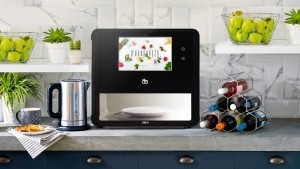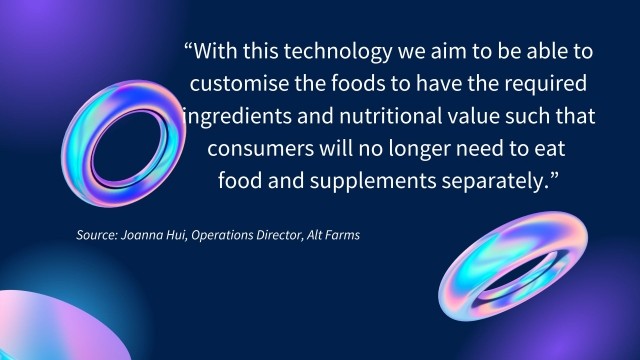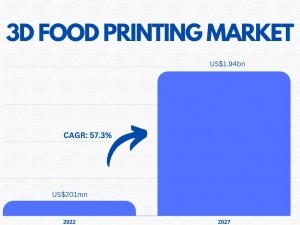Although the idea of 3D printing has been around for several decades, the idea of applying this technology to the food industry really only took off in the past few years.
Thank you for reading this post, don't forget to subscribe!The industry’s relatively short history as well as strong media association of this sector with futuristic applications – e.g. the printing of usable guns á la Hotel Artemis – has essentially kept 3D food printing out of the limelight.
According to Natural Machines, creator of what the firm claims to be the ‘first real 3D food printer’ Foodini which is the only CE and FCC certified 3D food printer on the market, these challenges are even more pronounced in the APAC region as exposure to this technology has been relatively short.

“We very commonly see consumers assuming that 3D food printing refers to the printing out of plastic food models,” Natural Machines Co-Founder and CMO Lynette Kucsma told FoodNavigator-Asia.
“One of the reasons for this of course is that these plastic models are very commonly found in APAC markets such as Japan, where many restaurants have these plastic food models displayed outside their stores to show consumers what their dishes look like.
“This however has led to the misunderstanding that 3D food printing is the same thing, and we have often had to explain a lot more in detail as compared to markets that are more mature in this area such as Europe and the United States.”
Even so, Natural Machines has maintained an office in Beijing, China as it still believes that APAC has strong potential for 3D food printing growth.
“There is also a clear willingness amongst APAC consumers to use and try new technology, so the interest level here is high,” she said.
“The key is to get the awareness up and once that is achieved, the ‘fear factor’ barrier is actually lower here.”
Theoretically the applications for food are very broad and very customisable, with most proponents of the technology citing benefits such as hyper-personalised nutrition due to being able to specifically choose the ingredients used to make individualised meals for consumers; or even providing more aesthetic capabilities in the form of designs and novel flavours.
Hong Kong-based Alt Farm, a spin-off of the Hong Kong University of Science and Technology (HKUST) has developed a novel 3D food printing tech with a nozzle enabling it to print foods with specific textures according to user preference.
This sets it apart considerable from conventional 3D food printers that produce products which tend to have a gelatinous texture once printed and need extra processing such as baking or frying before consumption.
“The key difference for us is that we set out to produce foods that are targeted at regular consumers and not just to make softer foods for the elderly or provide personalisation of soft products such as chocolates,” Alt Farm Managing Director Kenny Fung told us.
“This nozzle contains separate chambers for different biochemical enzymatic reactions to take place so as to solidify the printed product and also generate different textures such as a fibrous texture for plant-based meat, a crunchy texture for bakery products, a chewy texture for confectionary and so on.”
The end-goal for the firm is to develop its technology to the point where complete dietary and nutrition personalisation can be achieved via 3D-printed food products.
“With so many consumers today focused on becoming healthier and looking all over for things like organic or gluten-free foods, there has really been a rise in interest for products that can give them the nutrients they need,” Alt Farm Operations Director Joanna Hui added.
“It is very common for them to do tests to check on what nutrients or minerals they are missing in the body and have nutritionists prescribe them health supplements for that.
“With this technology we aim to be able to customise the foods to have the required ingredients and nutritional value such that consumers will no longer need to eat food and supplements separately.”
Before that can be achieved though, the industry still needs to overcome the major hurdle of getting to mass production scale.
“The major challenge for the industry lies with printing capacity, because at this point in time it can take a very long time for the printing of a single product to be completed, so a lot more work is needed in this area,” Fung said.
“We do feel that the easiest way right now would actually be to just make more printers to print more food simultaneously – [although] conventional 3D food printer costs can be much higher in the open market, [reaching the tens of thousands of dollars per machine], for us the cost is not too high right now as we have the know-how to get 3D printers for perhaps a few thousand dollars and then use open-source software and so on to modify these to become 3D food printers.
“From there, we would still want to work even further on the printing capacity, but especially since our main goal is to make retail products, we definitely need to look at reaching mass production scale to get there.”
Watch the video below to find out more.
APAC potential
Within the APAC region, Singapore has had some of the widest exposure to 3D food printing and firms such as locally-based Anrich3D believe that its multicultural food scene as well as health awareness could well transfer over to higher acceptance of the technology.
“Singapore has a lot of different ethnicities and cuisines that are cherished in the local FnB scene [and consumers] show a strong inclination toward health and nutrition,” Anrich3D Founder Anirudh Agarwal told us.
“With this wide variety of flavour profiles to work with and a natural tendency toward healthier eating, 3D food printing has a great chance of building a foothold in Singapore, [and is also a good] launchpad for technologies and business models to expand internationally, especially into ASEAN and India.
“The purpose of making an industrial multi-material food 3D printer is to create balanced meals without having to use any supplements. There are already many existing resources for personalised nutrition advice [and] we just want to convert that information into actual meals by depositing precise amounts of different ingredients in a meal configuration that gives the desired diet.”
That said, it is no secret that Singapore has one of the smallest populations in the region, and as such the firm has also set its sights on bringing its technology into other Asian markets in the hope that its start in Singapore can springboard it to these markets.
“One of the regions best suited for various 3D food printing applications is India which has a large population and a family structure that makes it very appealing for home-based 3D food printers as well as 3D food printing in the foodservice sector,” he said.
“There is also Japan which is basically synonymous with robotics, automation and vending machines, [so it would definitely] be ideal for an automated restaurant concept utilising 3D printed food.
“Outside of APAC there are definitely various markets that are already embracing the benefits of this tech such as Spain and the Netherlands, as well as the United States.”
Sustainability applications
Kucsma added that one area in which 3D food printing can be applied which could show particular appeal for APAC markets is in the upcycling of food.
“3D food printing can reduce food waste throughout the food value chain in various ways – one of these is from a consumer point of view, via the customisation of portion sizes so that people can print what they want to eat and nothing more,” she said.
“Another way is by recovering food that is traditionally classified as food waste – such as ‘ugly’ fruits, vegetables, and cuts of meat – and printing these foods, upcycling them to making them an attractive and nutritious food source.”
A good example is the use of okara, a by-product of soy milk and bean curd production that typically goes to waste, and a team of Japanese and Singaporean researchers from across several local universities recently created a method of using 3D printing to make okara snacks.
“3D printing food products can allow textural properties such as hardness and adhesiveness to be controlled, attributes which are crucial in affecting individual sensations experienced during food consumption,” said the researchers.
There are also other more unique ways to utilise 3D food printing for sustainability progress, one of which is to make unfamiliar food sources such as insect-based proteins look and feel more palatable.
“3D food printing [can] transform the way in which food is presented, and overcome the inertia of consumer inhibitions,” Singapore University of Technology and Design’s Professor Chua Chee Kai said.
“The appeal of unfamiliar proteins like crickets can be increased by combining them with common foods like carrots to produce a more familiar taste, then extruding this mixture with a 3D food printer.”
The insect-based protein industry is another food sector that has yet to find mainstream success despite clearly proven sustainability benefits due to many consumers having trouble overcoming what is commonly known as the ’ick’ factor, which is what 3D food printing is hoped to be able to help with.
Not limited to plant-based
There is a common misconception that only plant-based ingredients can be used in 3D food printing, and this has been greatly fuelled by many firms looking to focus on developing plant-based products as their initial launches, including Alt Farm which is looking at launching a 3D-printed plant-based steak.

The need for conventional machines to use solely purees for 3D food printing has also fed the misconception that it is necessary to use ingredients such as pumpkin or sweet potato or chocolate or the like, when there is actually a much broader range of potential ingredients.
“The use of pureed plant-based foods is common but not mandatory, it is also possible to make other texturised food products using ground beef and meats,” Kucsma said.
“It is also not mandatory to print only with a paste consistency [as Foodini has nozzles] available in several different sizes so things like whole couscous, or burgers with chunks of cranberries and walnuts can be printed as long as the food fits through the nozzle.
“It is even possible to print a meat-based hamburger using raw meats and then cook this after printing.”
Agarwal added that there is currently a lot of industry interest in using 3D printing for making scaffolds or printing chunks of meat, an area that the company is very interested in pursuing.
“The idea is to be able to use all kinds of ingredients as required by consumers, so we will make our printer as versatile as possible to work with a large variety of ingredients,” he said.
Big brands involvement
It is not only smaller firms that are focused on developing the 3D food printing sector, but also large brands like Hershey.
Hershey in particular is working on 3D printing options for its chocolates, with an eye for personalisation.
“3D printed chocolate could become a permanent fixture at our retail stores [where] consumers would be able to design their own chocolates and have it printed in front of their own eyes,” the company said.
“3D printing gives consumers nearly endless possibilities for personalising their chocolate.”
The firm has even co-developed a 3D food printer in collaboration with tech firm 3DS, dubbed the CocoJet.

Other firms are involved in less direct ways than actually printing out the food products for the moment, but it is no secret that there is clear vision of 3D printing as part of the food industry’s future.
“[There is] potential in using 3D printing for rapid prototyping such as optimising the design for a snack or quickly creating parts for machines like extruders to test new snacking concepts,” PepsiCo’s Dr Anshul Dubey said.
“The applications for this technology may not be focused so much on mass-producing the finished food products [but] there is certainly potential for it to be used more.”
The firm recently announced that it had made progress in reducing its prototype tool development time from four weeks to just 48 hours with the use of 3D printing, and cut costs by some 96%.
“Time and cost are obviously important, but more important is to have the ability to have the flexibility to run through a number of different design iterations at a [high] pace,” PepsiCo Senior Manager of Global Packaging, R&D, Advanced Engineering and Design Max Rodriguez said in a separate statement.
“[This is so] that we can evaluate performance in all of the downstream activities [as] that really is what helps us accelerate.”
Nestle has also used 3D printing to accelerate prototyping and market launches, for example in the development of packaging that can handle nitrogen-infused coffee products.
Foodini has also worked with various big names including Nestle, Maxim’s and PepsiCo on various projects, showing that brand interest in this technology is alive and well.
“We are working with food and beverage firms that are looking to get away from a generic one-size-fits-all offering,” Kucsma said.
“The idea is to be able to customise foods for individual consumers [to give them] some form of control, yet still use and consume their products, as there is a lot of potential predicted from this space whether you look at it from a health, sustainability or personalisation point fo view.”




